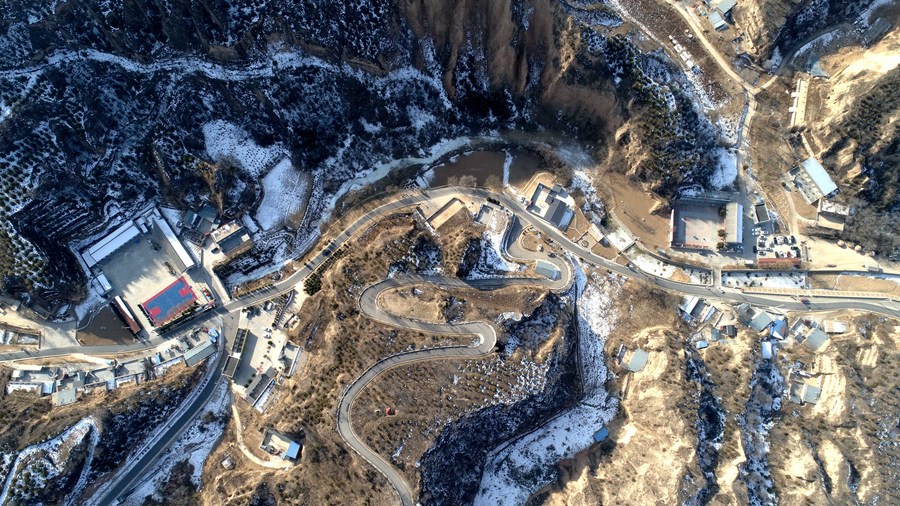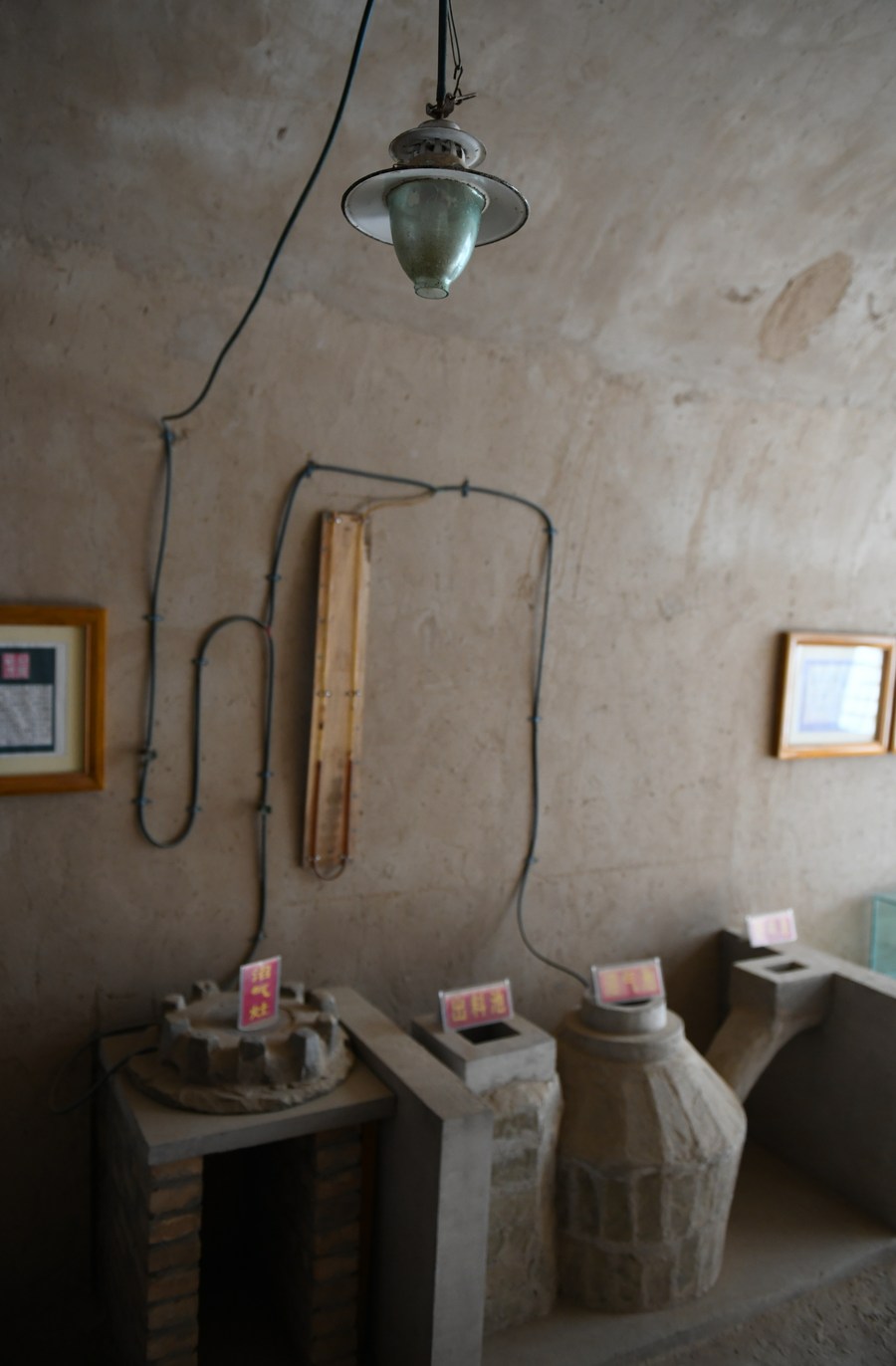by Xinhua writer Xue Yanwen
BEIJING, March 8 (Xinhua) -- Today, natural gas keeps homes across the village of Liangjiahe warm and cozy. Around half a century ago, it was a different story: families still relied on open fires.
"In the past, the environment was not good. For generations, even firewood was a rarity across our barren mountains," said Liu Jinlian, villager of Liangjiahe in Shaanxi Province, northwest China.

Aerial photo taken on Jan. 4, 2021 shows a view of the Liangjiahe Village of Yanchuan County in Yan'an, northwest China's Shaanxi Province. (Xinhua/Liang Aiping)
For generations, people eked out an existence on the unforgiving Loess Plateau in northern Shaanxi Province. It was this harsh environment that struck the future president of China.
In 1969, 15-year-old Xi Jinping arrived in Liangjiahe under a campaign that saw tens of millions of urban educated youth live and work in the countryside.
This small village was where Xi took his first steps on a professional journey that would see him rise to president.
In 1974, Xi joined the Communist Party of China (CPC) and became the Party secretary of Liangjiahe.
"Why did we make him our Party secretary? He was good at planning and finding solutions, he was well-educated, and he was tough in the face of hardship and good at farm work," said Liu.
As Liangjiahe village Party secretary, Xi spearheaded a series of initiatives that benefited villagers, shaping him into "the man of the people."
After he took up his post, the first thing he did was to build a dam. At that time, floods from the mountain often washed away the farm soil. He worked day and night to build the dam, carrying stones and digging the ground. When the dam was completed, the soil moved by the floods settled in the fields, and the land became more fertile.
After taming the waters, Xi turned his eyes to fire. He decided to build a methane tank, which could provide villagers with gas for their cookers and lights.
"Back then, some of the older generation were set in their ways. They said, 'how could it be possible to start a fire by digging a tank and storing up some manure?'," said Shi Chunyang, a villager who helped with the project.
Xi traveled to Sichuan to learn about the province's building techniques. On his return to Liangjiahe, he found out practice was harder than theory.
"The digging of the first methane tank was difficult," Xi recalled, "The water around the tank kept rising, but there was no sign of gas. The problem turned out to be a blocked pipe. When we finally cleared the obstruction, the pipe splashed manure over my face. Immediately, gas started leaking, so we quickly connected the pipe to the stove. An over 30-cm high flame rose up above our methane stove."
"In Liangjiahe, we lit up the first biogas lamp in the whole of Shaanxi Province. We all cooked and got lighting with methane. Biogas digestates were also ideal fertilizers for our farmland," said Shi.

Photo taken on Jan. 5, 2021 shows the model of a biogas system in Liangjiahe Village of Yanchuan County in Yan'an, northwest China's Shaanxi Province. (Xinhua/Li Yibo)
Following these successful projects, Xi set up a sewing workshop, where women would make clothes for their fellow villagers; a consignment store, where the community could buy and sell groceries and other products; a classroom, where villagers learned to read and write; and a mill, with equipment donated by Xi, that could be used by everyone.
Among all the many "educated youth" who came to Yan'an, Xi was the first to become a village Party chief, and he was awarded a motorcycle. He said it was not useful to the village, so he exchanged it for a tractor, a flour-milling machine and a grain thrower. He donated these items to the village to open a mill.
"These items were very helpful for us," said Shi.
"Anything we needed, he did it at once. Everything he did was to benefit the villagers," said Liu.
Xi calls Liangjiahe his second home. Later in his career, he penned an article, writing that he felt perplexed when he came to the "yellow earth " at the age of 15, but upon leaving at 22, he had a firm goal of life and was full of confidence. "As a people's servant, I'm rooted in the northern Shaanxi plateau. This place has cultivated my unchangeable philosophy -- I must do practical things for the people!"
"From Liangjiahe village Party secretary, to general secretary of the Communist Party of China Central Committee, his heart is always with the people," said Shi.

Tourists visit Liangjiahe Village of Yanchuan County in Yan'an, northwest China's Shaanxi Province, July 29, 2020. (Xinhua/Zhang Bowen)
Just like in Liangjiahe, in each of the more than 530,000 villages in China, village Party secretaries are fundamental to the practice of Party's people-centered approach; they must lead the whole village and "do practical things for the people."
After Xi Jinping left Liangjiahe, the baton of office was passed on, and life in Liangjiahe continued to improve. In 2018, Liangjiahe became one of the earliest villages in the region to bid farewell to absolute poverty. In recent years, the per capita annual income of Liangjiahe has exceeded 20,000 yuan (3,088 U.S. dollars), according to Gong Baoxiong, current Liangjiahe village Party secretary.
The years in Liangjiahe sparked a fire in Xi: it ignited the core idea of serving the people, which has guided him throughout his political career, and helped catalyze the country's poverty elimination drive and warmed the hearts of the people.
(Video reporters: Liang Aiping, He Zhanjun, Li Yibo, Yao Youming) ■




